 The Foodlady left her camera card behind so there are no photos to show of their Sunday walk this week. Pity, as by all accounts the disas were so plentiful that in the end they were all disa-ed out. They toiled up Skeleton Gorge - only Sue, the Alpha and the FL in the end - the others all ailing or entertaining. (These photos are from last year).
The Foodlady left her camera card behind so there are no photos to show of their Sunday walk this week. Pity, as by all accounts the disas were so plentiful that in the end they were all disa-ed out. They toiled up Skeleton Gorge - only Sue, the Alpha and the FL in the end - the others all ailing or entertaining. (These photos are from last year). 
 The Food Lady thought that this was a good opportunity to provide some facts that she found in Colin Paterson Jones's book Table Mountain Walks and Jose Burman's The Table Mountain Book.
The Food Lady thought that this was a good opportunity to provide some facts that she found in Colin Paterson Jones's book Table Mountain Walks and Jose Burman's The Table Mountain Book.  They had a tea stop at the top of Window Gorge in among lots of flowering red disas. Window Gorge is where one of the streams that flows into the Liesbeek River starts. (The other is at the top of Skeleton Gorge.)
They had a tea stop at the top of Window Gorge in among lots of flowering red disas. Window Gorge is where one of the streams that flows into the Liesbeek River starts. (The other is at the top of Skeleton Gorge.)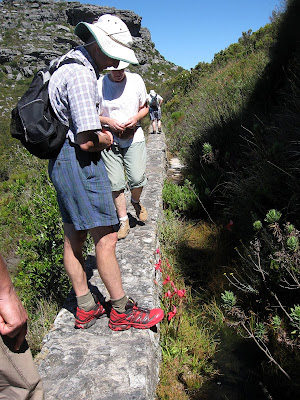 They then walked on to the Aqueduct (made famous by Paul's red hiking boots last year) which was built in the late 1800s to channel water into the Woodhead and Hely-Hutchinson dams.
They then walked on to the Aqueduct (made famous by Paul's red hiking boots last year) which was built in the late 1800s to channel water into the Woodhead and Hely-Hutchinson dams. Then it was down the gorge that skirts Junction Peak and ends up at the dams which they crossed. There were lots and lots of people (and dogs!) in the Cool Pools.  En route to the top of Nursery Ravine, this little clump of firs, silver birches and oaks and some ruined mossy stone walls are all that's left of the Superintendent of Plantations in the Cape, Joseph Storr Lister's Oudekraal Tree Nursery established in 1884. (He also set up the Tokai Arboretum.) Lister appointed a forester, Paul Schickerdanz, as Forest Guard for Table Mountain and gave him the task of establishing a nursery for exotic plantation trees u[ there. At one stage there were blackwoods (Acacia melanoxylon), silver birches (Betula pendula), firs (Chamaecyparis lawsoniana, Cryptomeria japonica and Cupressus species), pines (Pinus radiata), ash (Fraxinus species), elm (Ulmas procera) and Turkey oaks (Quercus cerris). Some of the plantations were inundated when the Hely Hutchinson Dam was built, and the rest have been felled, save for a few of the non-invasive ones - some ancient old firs (Cryptomeria japonica), some silver birches and some Turkey oaks. Indigenous species have also been planted there now - yellowwoods (Podocarpus latifolius), Rooiels (Cunonia capensis) and Cape Beech (Rapanea melanophloeos).
En route to the top of Nursery Ravine, this little clump of firs, silver birches and oaks and some ruined mossy stone walls are all that's left of the Superintendent of Plantations in the Cape, Joseph Storr Lister's Oudekraal Tree Nursery established in 1884. (He also set up the Tokai Arboretum.) Lister appointed a forester, Paul Schickerdanz, as Forest Guard for Table Mountain and gave him the task of establishing a nursery for exotic plantation trees u[ there. At one stage there were blackwoods (Acacia melanoxylon), silver birches (Betula pendula), firs (Chamaecyparis lawsoniana, Cryptomeria japonica and Cupressus species), pines (Pinus radiata), ash (Fraxinus species), elm (Ulmas procera) and Turkey oaks (Quercus cerris). Some of the plantations were inundated when the Hely Hutchinson Dam was built, and the rest have been felled, save for a few of the non-invasive ones - some ancient old firs (Cryptomeria japonica), some silver birches and some Turkey oaks. Indigenous species have also been planted there now - yellowwoods (Podocarpus latifolius), Rooiels (Cunonia capensis) and Cape Beech (Rapanea melanophloeos).
 En route to the top of Nursery Ravine, this little clump of firs, silver birches and oaks and some ruined mossy stone walls are all that's left of the Superintendent of Plantations in the Cape, Joseph Storr Lister's Oudekraal Tree Nursery established in 1884. (He also set up the Tokai Arboretum.) Lister appointed a forester, Paul Schickerdanz, as Forest Guard for Table Mountain and gave him the task of establishing a nursery for exotic plantation trees u[ there. At one stage there were blackwoods (Acacia melanoxylon), silver birches (Betula pendula), firs (Chamaecyparis lawsoniana, Cryptomeria japonica and Cupressus species), pines (Pinus radiata), ash (Fraxinus species), elm (Ulmas procera) and Turkey oaks (Quercus cerris). Some of the plantations were inundated when the Hely Hutchinson Dam was built, and the rest have been felled, save for a few of the non-invasive ones - some ancient old firs (Cryptomeria japonica), some silver birches and some Turkey oaks. Indigenous species have also been planted there now - yellowwoods (Podocarpus latifolius), Rooiels (Cunonia capensis) and Cape Beech (Rapanea melanophloeos).
En route to the top of Nursery Ravine, this little clump of firs, silver birches and oaks and some ruined mossy stone walls are all that's left of the Superintendent of Plantations in the Cape, Joseph Storr Lister's Oudekraal Tree Nursery established in 1884. (He also set up the Tokai Arboretum.) Lister appointed a forester, Paul Schickerdanz, as Forest Guard for Table Mountain and gave him the task of establishing a nursery for exotic plantation trees u[ there. At one stage there were blackwoods (Acacia melanoxylon), silver birches (Betula pendula), firs (Chamaecyparis lawsoniana, Cryptomeria japonica and Cupressus species), pines (Pinus radiata), ash (Fraxinus species), elm (Ulmas procera) and Turkey oaks (Quercus cerris). Some of the plantations were inundated when the Hely Hutchinson Dam was built, and the rest have been felled, save for a few of the non-invasive ones - some ancient old firs (Cryptomeria japonica), some silver birches and some Turkey oaks. Indigenous species have also been planted there now - yellowwoods (Podocarpus latifolius), Rooiels (Cunonia capensis) and Cape Beech (Rapanea melanophloeos). Why in Heaven's name did they want to grow trees up here in this remote spot one asks. Well, the prevailing thought in those long ago days was that trees increased water run-off in catchment areas. It has now been conclusively demonstrated that the indigenous vegetation is more efficient for this purpose - in fact it is much more efficient because the exotic trees suck up any available moisture at a great rate, which is then lost through their leaves.
(For more on this nursery and Schickerdanz, click here for a previous post that included us scotties in the walk, when this photo was taken.)













































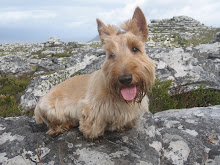
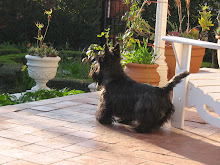






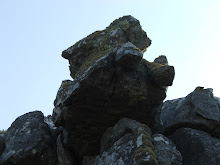





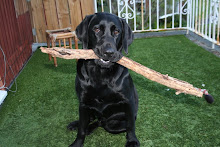






































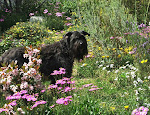



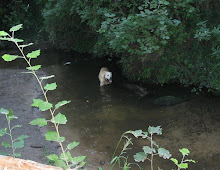



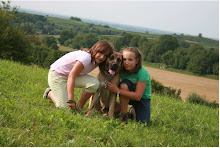










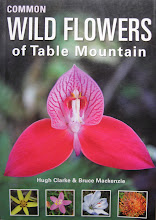


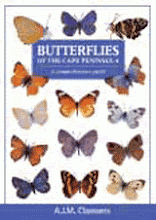






No comments:
Post a Comment